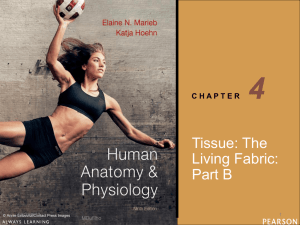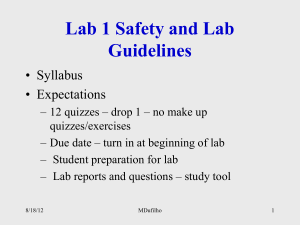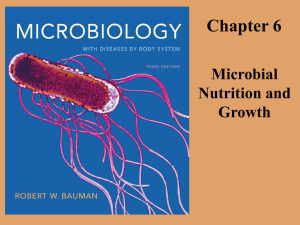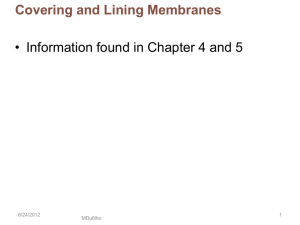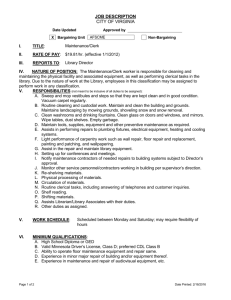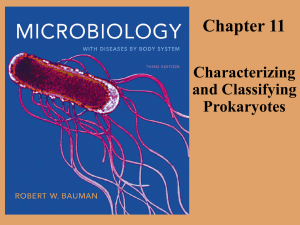Chapter 4 Part 2 Inflammation and Tissue Repair
advertisement
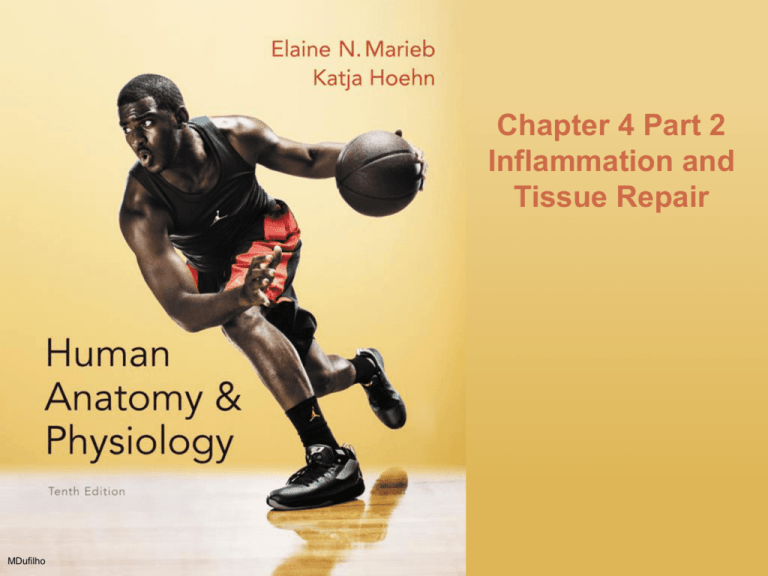
Chapter 4 Part 2 Inflammation and Tissue Repair © Annie Leibovitz/Contact Press Images MDufilho Steps in Tissue Repair • Repair can occur in two major ways: – Regeneration: same kind of tissue replaces destroyed tissue, so original function is restored – Fibrosis: connective tissue replaces destroyed tissue, and original function lost • Step 1: Inflammation sets stage – Release of inflammatory chemicals causes: • Dilation of blood vessels • Increase in blood vessel permeability – Clotting of blood occurs 9/8/2015 MDufilho 2 Figure 4.12-1 Tissue repair of a nonextensive skin wound: regeneration and fibrosis. Scab Epidermis Vein Inflammatory chemicals 9/8/2015 MDufilho Blood clot in incised wound Migrating white blood cell Artery 1 Inflammation sets the stage: • Severed blood vessels bleed. • Inflammatory chemicals are released by injured tissue cells, mast cells, and others. • Local blood vessels become more permeable, allowing white blood cells, fluid, clotting proteins, and other plasma proteins to seep into the injured area. • Clotting occurs; surface exposed to air dries and forms a scab. 3 Inflammatory Response • Inflammatory mediators – Histamine (from mast cells) – Kinins, prostaglandins (PGs), and complement • Dilate local arterioles (hyperemia) – Causes redness and heat of inflamed region • Make capillaries leaky • Many attract leukocytes to area • Some have inflammatory roles 9/8/2015 MDufilho 4 Inflammatory Response: Edema • Capillary permeability exudate to tissues – Fluid containing clotting factors and antibodies – Causes local swelling (edema) – Swelling pushes on nerve endings pain • Pain also from bacterial toxins, prostaglandins, and kinins – Moves foreign material into lymphatic vessels – Delivers clotting proteins and complement 9/8/2015 MDufilho 5 Steps in Tissue Repair (cont.) • Step 2: Organization restores blood supply – Organization begins as the blood clot is replaced with granulation tissue (new capillaryenriched tissue) – Epithelium begins to regenerate – Fibroblasts produce collagen fibers to bridge the gap until regeneration is complete – Any debris in area is phagocytized 9/8/2015 MDufilho 6 Figure 4.12-2 Tissue repair of a nonextensive skin wound: regeneration and fibrosis. Regenerating epithelium Area of granulation tissue ingrowth Fibroblast Macrophage Budding capillary 2 Organization restores the blood supply: 9/8/2015 MDufilho • The clot is replaced by granulation tissue, which restores the vascular supply. • Fibroblasts produce collagen fibers that bridge the gap. • Macrophages phagocytize dead and dying cells and other debris. • Surface epithelial cells multiply and migrate over the granulation tissue. 7 Steps in Tissue Repair (cont.) • Step 3: Regeneration and fibrosis effect permanent repair – The scab detaches – Fibrous tissue matures – Epithelium thickens and begins to resemble adjacent tissue – Results in a fully regenerated epithelium with underlying scar tissue, which may or may not be visible 9/8/2015 MDufilho 8 Figure 4.12-3 Tissue repair of a nonextensive skin wound: regeneration and fibrosis. Regenerated epithelium Fibrosed area 9/8/2015 MDufilho 3 Regeneration and fibrosis effect permanent repair: • The fibrosed area matures and contracts; the epithelium thickens. • A fully regenerated epithelium with an underlying area of scar tissue results. 9 Clinical Applications • Benadryl (an antihistamine) – blocks receptor site (H1) for histamine receptors • Aspirin/Ibuprofen – inhibits formation/action of prostaglandins – reduces pain and fever • Cortisone cream – inhibits release/action of inflammatory chemicals • Naproxen – prevents formation of prostaglandins 9/8/2015 MDufilho 10 Regenerative Capacity of Different Tissues • Tissues that regenerate extremely well include: – Epithelial tissues, bone, areolar connective tissue, dense irregular connective tissue, bloodforming tissue • Tissue with moderate regenerating capacity: – Smooth muscle and dense regular connective tissue • Tissues with virtually no functional regenerative capacity: – Cardiac muscle and nervous tissue of brain and spinal cord 9/8/2015 MDufilho 11 Clinical – Homeostatic Imbalance 4.3 • Scar tissue that forms in organs, particularly the heart, can severely impair the function of that organ – May cause the organ to lose volume capacity – May block substances from moving through organ – May interfere with ability of muscles to contract or may impair nerve transmissions 9/8/2015 MDufilho 12 Clinical – Homeostatic Imbalance 4.3 • Scar adhesions may cause organs to adhere to neighboring structures, preventing normal functions • Scarring can potentially cause progressive failure of the organ, particularly the heart 9/8/2015 MDufilho 13 Aging Tissues • Normally function well through youth and middle age if adequate diet, circulation, and infrequent wounds and infections • Epithelia thin with increasing age so more easily breached • Tissue repair less efficient • Bone, muscle and nervous tissues begin to atrophy • DNA mutations possible increased cancer risk 9/8/2015 MDufilho 14
